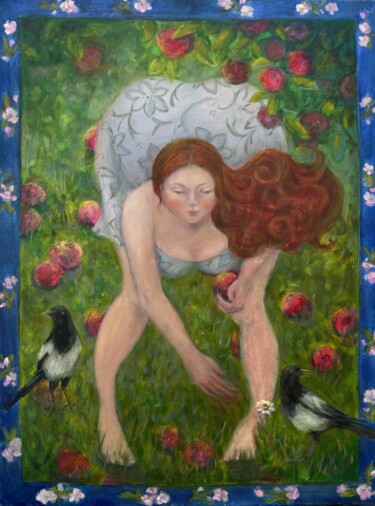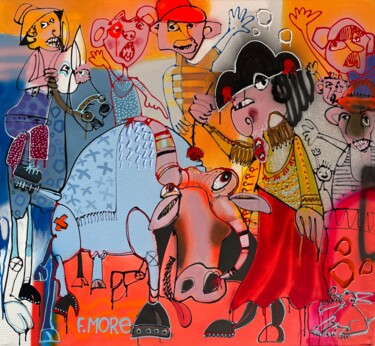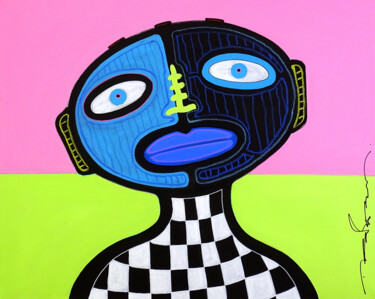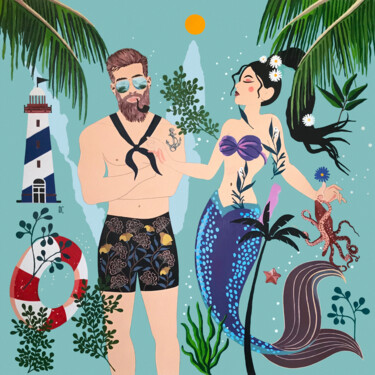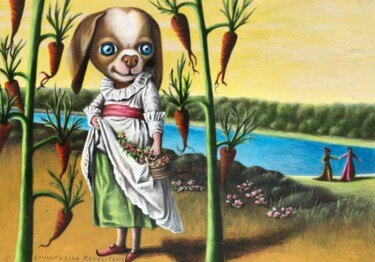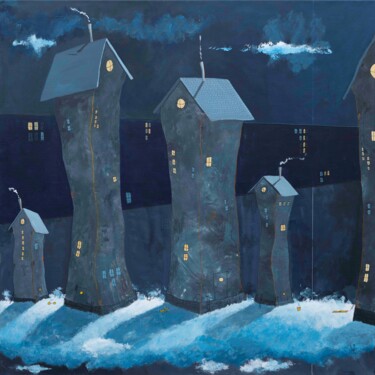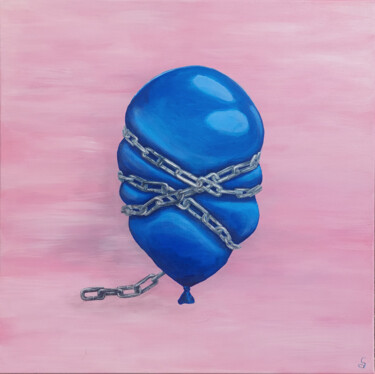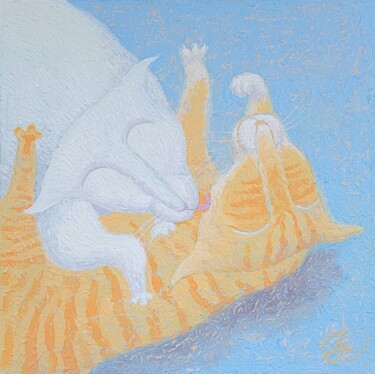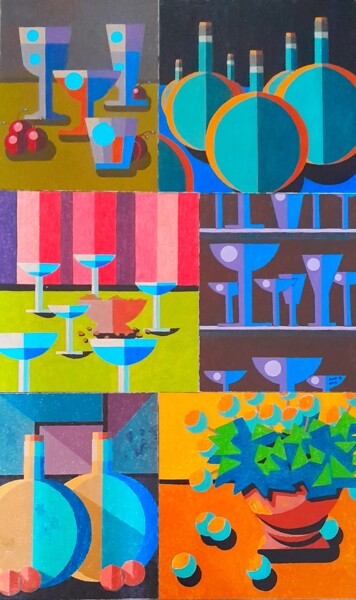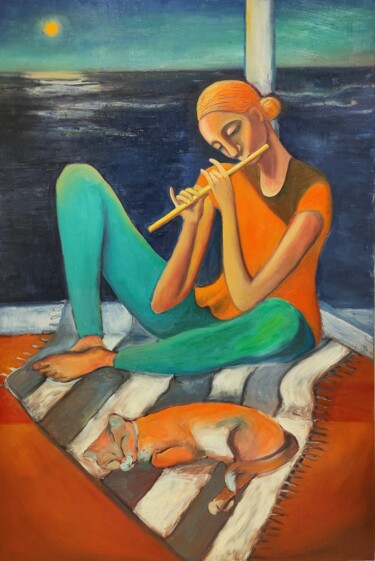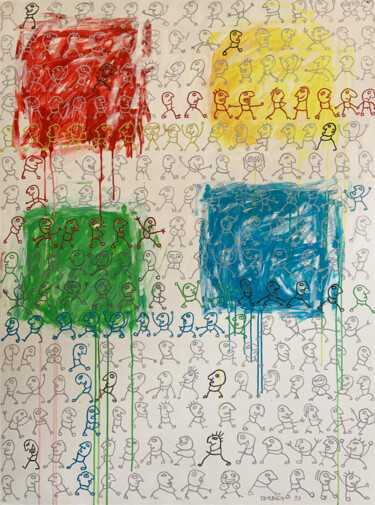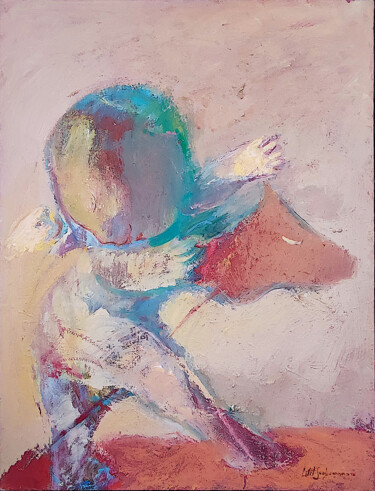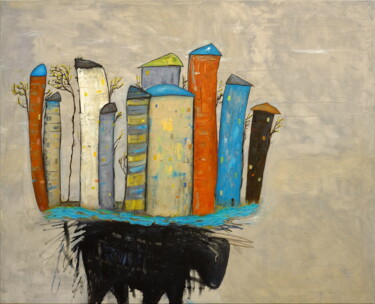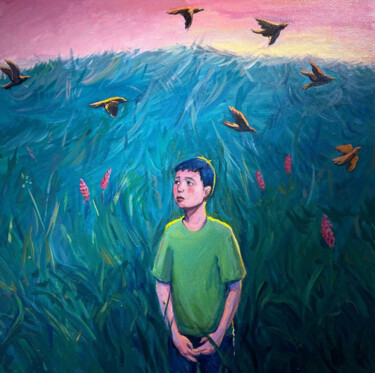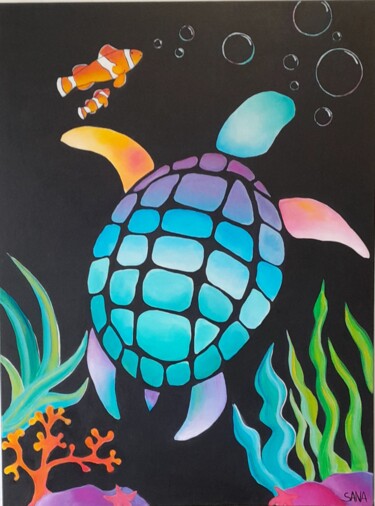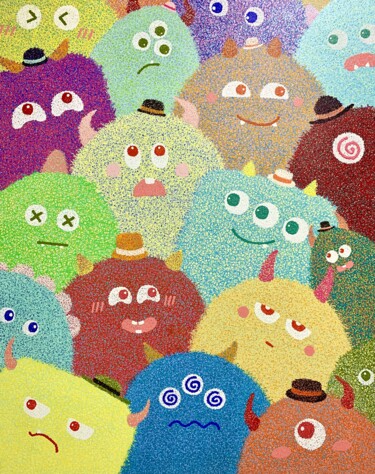511 Originalgemälde zu verkaufen:
Wie definiert man Naive Kunst Stil ?
What is a Naive painting?
Naive painting is a style of art that was started by artists like Henri Rousseau who didn't know much about art. Most of the time, naive art is defined as visual art made by someone who hasn't had the training and education that a professional artist does. When a professional artist tries to copy this style, it is often called "primitivism."
What are the characteristics of Naive painting?
Naive art is usually defined as visual art made by someone who doesn't have the formal training and education that a professional artist does (in anatomy, art history, technique, perspective, ways of seeing). When a trained artist tries to copy this style, it is sometimes called primitivism, pseudo-naive art, or faux naive art.
Unlike folk art, naive art doesn't have to come from a specific popular cultural context or tradition. In fact, at least in advanced economies and since the Printing Revolution, it's impossible not to know about the local fine art tradition, which has spread through popular prints and other media. Naive artists know about "fine art" conventions like graphical perspective and compositional conventions, but they can't or don't use them to their full potential. Outsider art (also called "art brut"), on the other hand, refers to works that come from a similar background but have little to do with the mainstream art world.
Naive art is known for being simple and honest like a child, and this is why it is often copied. These kinds of paintings usually have a flat style of drawing and a simple way of showing depth. Henri Rousseau, a French Post-Impressionist who lived from 1844 to 1910 and was discovered by Pablo Picasso, was one of the most important painters of "naive art."
There has been some disagreement about what the term means and where it "ends" with other terms like folk art and outsider art. Naive art is usually used to describe works of fine art made by self-taught artists, like paintings and sculptures. Folk art, on the other hand, refers to things that can be used in everyday life. But this difference has been argued about. [6] "Provincial" is another word that can be used, especially for paintings and buildings. It is mostly used to describe work by artists who have had some traditional training but whose work falls short of metropolitan or court standards by accident.
By what do naive paintings stand out?
People often think of naive art as art made by someone who hasn't had any formal training or a degree, or hasn't had much. Before the 20th century, this was true, but now there are schools for naive art. Naive art is now a fully recognized type of art that can be seen in galleries all over the world.
The features of naive art don't fit well with the formal aspects of painting, especially when the three rules of perspective aren't followed (as described by the Progressive Painters of the Renaissance):
-Objects get smaller as you get farther away,
-Colors become less clear as you get farther away;
-Details become less clear as you get farther away.
Here are the results:
-Geometrically wrong effects of perspective (awkward parts of the works, like how children's drawings or paintings from the Middle Ages look, but that's where the comparison ends);
-Effects of perspective that aren't quite right. Strong use of pattern, unrefined color on all the plans of the composition, without enfeeblement in the background;
-Equal attention to details, including those in the background that should be shaded off.
People say that naive art is easy to spot because it is not complicated. It has become so popular and well-known, though, that many examples could be called "pseudo-naive." "Pseudo naive" or "faux naive" art is the work of an artist who is more imitative or self-conscious and whose work looks more copied than original. "Naive" art is the work of an artist who did not go to art school or academy, like Henri Rousseau or Alfred Wallis.
Since Autodidactism has become more popular as a way to learn in modern times, strict naiveté is not likely to be found in modern artists. Living artists don't always like naive categorizations, but this is likely to change as more dignifying signals become known. There are now museums for naive art in Kecskemét, Hungary; Kovaica, Serbia; Riga, Latvia; Jaen, Spain; Rio de Janeiro, Brazil; Vicq, France; and Paris. Gary Bunt, Lyle Carbajal, Gabe Langholtz, Gigi Mills, Barbara Olsen, Paine Proffitt, and Alain Thomas are all English-speaking living artists who admit to having a naive style.
"Primitive art" is another term that people who haven't studied art often use to describe it. Historically, though, it has been used more to describe art from cultures that Western academia has deemed "primitive" socially or technologically, like Native American, sub-Saharan African, and Pacific Island art (see Tribal art). This is different from the "primitive"-inspired, self-aware movement called "primitivism." Folk art is another term that is similar to naive art but not the same thing.
There are also the terms "navism" and "primitivism," which are usually used to describe professional painters who use naive art as their style (like Paul Gauguin, Mikhail Larionov, Paul Klee).
What is the history of the Naive movement?
No one knows exactly when the first naive artists started making art, but from the very beginning of art to the time of the "Modern Classic," naive artists have left behind clear signs of their creative work. At the very least, naive art has been "official" in the history of 20th-century art since 1912, when an almanac called Der Blaue Reiter was published. Wassily Kandinsky and Franz Marc, who made the almanac, showed six copies of Henri Rousseau's paintings and talked about how they were different from other pictures. Most experts agree, though, that naive art was "discovered" in 1885, when the painter Paul Signac learned about Henri Rousseau's skills and started putting on shows of his work in some of the best galleries in Paris.
The Sacred Heart painters
Wilhelm Uhde, a German art collector and critic, is known for being the main person in charge of the first Naive Art show, which took place in Paris in 1928. Henri Rousseau, André Bauchant, Camille Bombois, Séraphine Louis, and Louis Vivin all took part. Together, they are known as the Sacred Heart painters.
Earth Group
The Earth Group (Grupa Zemlja) was a group of artists, architects, and thinkers from Croatia who lived and worked in Zagreb from 1929 to 1935. The group was Marxist and was partly based on "Neue Sachlichkeit,"[19] which led to more stylized forms and the start of Naive painting. In the group were painters Krsto Hegedui, Edo Kovaevi, Omer Mujadi, Kamilo Ruika, Ivan Tabakovi, and Oton Postrunik, sculptors Antun Augustini and Frano Krini, and the architect Drago Ibler. The Earth group tried to figure out how to solve social problems. Their program stressed the importance of creative freedom and was against blindly copying styles from other countries. They didn't want to make art just for the sake of art. Instead, they thought it should reflect the real world and the needs of the modern community. The government of the time was getting more and more upset by what was going on at the group's exhibitions, so in 1935, the group was banned.
Hlebine School
From about 1930 on, this term was used to describe naive Croatian painters who worked in or around the village of Hlebine, which is near the border with Hungary. At this time, the village was just "a few muddy, winding streets and one-story houses," according to the World Encyclopedia of Naive Art (1984). However, it produced such a great crop of artists that it became almost synonymous with Yugoslav naive painting.
Hlebine is a small, beautiful town in the north of Croatia. In the 1920s, a group of self-taught peasants started to paint in a way that was different and even a little bit revolutionary. Leading intellectuals of the time, like the poet Antun Gustav Mato and Miroslav Krlea, the most famous name in Croatian literature, pushed for this. They wanted a unique national style of art that was not influenced by the West. Krsto Hegedui, a well-known artist from Hlebine, took these ideas and used them to start the Hlebine School of Art in 1930. He did this to find "rural artistic expression" on a national level.
Ivan Generali was the first master of the Hlebine School. He was also the first artist to create a unique style and reach a high level of art. After the Second World War, the next generation of Hlebine painters focused more on stylized, made-up pictures of life in the country. Generali stayed the most important person and helped other artists, including his son Josip Generali, get started. With the 1952 Venice Biennale and shows in Brazil and Belgium, the Hlebine school became known all over the world.
Some of the best known naive artists are Dragan Gaži, Ivan Generalić, Josip Generalić, Krsto Hegedušić, Mijo Kovačić, Ivan Lacković-Croata, Franjo Mraz, Ivan Večenaj and Mirko Virius.
What are some famous Naive paintings?
Naive art is made up of simple, childlike techniques and ideas. Because of this, modernists who don't like what they see as the fake sophistication of work made in the traditional system have praised it. Henri Rousseau is the best-known naive artist working today, so we'll start with one of his works.
The Dream (1910) by Henri Rousseau
The young girl has been taken to a jungle, where a local musician plays a brass instrument and sings to her. Yadwigha, who is half hidden by the jungle's shadows, reaches out to the musician while looking out over a beautiful view of jungle greenery with lotus petals, parrots, monkeys, an elephant, two lions, and a snake. The snake coming toward the scene in the lower right corner of the picture makes me think of the Garden of Eden. A pink snake moves through the bushes. Its shape, which is like a snake, looks like a woman's legs and hips.
In this piece of art, a naked model is sitting on a sofa, which brings together the familiar and the strange. The painting "The Dream" shows why the Surrealists liked Rousseau's work. It has amazing attention to detail, bright colors, and a strange mix of images.
At least 22 different shades of green were used to paint the jungle plants. Poet and art critic Guillaume Apollinaire was blown away by the work. "The painting is absolutely gorgeous!" he exclaimed. I don't think anyone will laugh this year."
This picture looks like a dream because the only thing in it is a naked woman lying on a sofa in the tropics. But it's not clear if the art shows Yadwigha's dream or Rousseau's. But one of the best things about the picture is how open it is to different interpretations. Rousseau's trips to the natural history museum and the Jardin des Plantes in Paris gave him ideas for this piece, which has a lush jungle, wild animals, and a mysterious horn player. "When I'm in these hothouses and see strange plants from other places, it feels like I'm entering a dream," the artist said of his visits.
Death ship (1942) by Alfred Wallis
The main idea behind Alfred Wallis's Death Ship is a huge black ship with dark gray steam billowing from it. Five sailors in black suits and caps can be seen as the ship moves over icy white water. This picture, which has a good name, is a great example of the kind of work Wallis did in his later years. They show how sad the artist was feeling at the time.
Wallis made these paintings while he was alone and his eyesight was getting worse and his mind was getting worse. No one knows for sure when Wallis finished making these last changes. They were made either while Wallis was living in the Madron poorhouse or just before he was sent there, which was something he had been afraid of for a long time. Death Ship disproves the idea that Wallis couldn't use deep and complicated symbolism in his work because he was a "naive" artist. The ship is a sign of death and destruction, which is more of a metaphor than a literal representation of the things Wallis paints. It is a mix of the feelings Wallis had when he was at sea and when he was near the coast of St. Ives.
The Broken Column (1944) by Frida Kahlo
After she was badly hurt in a car accident when she was 18, most of Frida Kahlo's self-portraits are about her physical and mental pain. As her health got worse, this theme came back and got much stronger as her life came to an end. Her graphic pictures of herself in pain show how hard it was for her to deal with physical problems and pain. "The Broken Column," a painting by Kahlo, was made soon after she had surgery on her back.
This was just one of many times she had to go to the doctor to fix problems caused by an injury she had in the past. Kahlo had to wear a steel corset while painting, which was different from the plaster casts she had worn before. In the picture, Kahlo is standing in a broken, empty place that looks like it has been through as much trouble and tragedy as she has. Due to a deep, jagged crack that runs the length of her almost-naked body, her spine looks like a broken Ionic stone column. Her spinal column looks like it's about to break, especially at the bottom. Nails of different sizes go through her whole body and face, making her pain even worse. She has a lot of tears running down her cheeks.
Kahlo painted herself naked at first, except for the medical support girdle she wears. Then she added a white covering that looks like it came from a hospital to cover her bottom half. Her breasts are showing, and even though her body has been cut up, her sensuality shines through. The way nails and sheets are shown also has strong echoes of the Christian symbol of martyrdom. Even though she is in pain, Kahlo's face shows that she is strong and will not give up. Even though her body has been hurt and tortured, it is clear that her spirit has not been hurt.
This is the end of our look at Naive art, a style that looks simple and childlike. This word is used to describe paintings made in cultures that are more or less advanced but don't have the traditional skills to draw things. The colors are bright and not natural, the view isn't scientific, and the meaning is literal or childish.
Suchst du Original Gemälde zu verkaufen ?
Entdecken Sie alle Stilrichtungen und alle Maltechniken in der zeitgenössische Malerei, Street Art, abstrakte Kunst, figurative Kunst, Landschaften, Porträts, Stillleben, Akte, Aquarell, Ölmalerei oder Acrylmalerei. Artmajeur ist für alle künstlerischen Befindlichkeiten und zelebriert Schönheit an Ihrer Seite für 20 Jahre mit mehr als zwei Millionen zeitgenössischen Kunstwerken die es zu entdecken oder zu erwerben gibt! Der weltweite Massstab für zeitgenössische Malerei. Entdecken Sie Werke zeitgenössischer Künstler aus der ganzen Welt, um Ihre Inneneinrichtung mit Klasse zu dekorieren! Einfacher Kunstliebhaber oder eingefleischter Sammler? Finden Sie die Lieblingsleinwand oder das Lieblingsgemälde, das Ihre Dekoration wirklich aufwertet. Artmajeur bietet Ihnen Originalwerke, limitierte Auflagen und Kunstdrucke der besten zeitgenössischen Künstler der Welt. Auf Artmajeur werden die Gemälde von Enthusiasten und Experten des Kunstmarktes ausgewählt. Wir wählen für Sie die Originalwerke trendiger, preisgekrönter und anerkannter Maler sowie neue steigende Werte im Bereich der zeitgenössischen Kunst aus, um Sie beim Online-Kauf von Gemälden zu leiten und zu unterstützen.
Entdecken Sie zeitgenössische KunstWerke auf Artmajeur
Zeitgenössische Kunst ist ein vibrierendes Netzwerk von künstlerischen Ausdrucksformen. Dieses kreative Universum umfasst eine breite Palette von Medien, von Gemälden, Skulpturen und Fotografien bis hin zu Zeichnungen, Gravuren, Textilkunst und digitalen Kunstwerken, wobei jedes Medium einen eigenen strahlenden Glanzstern darstellt. Künstler verwenden verschiedene Träger und Materialien, um ihre Visionen zum Leben zu erwecken, wie Leinwand, Holz, Metall und sogar innovative digitale Leinwände zur Schaffung von virtuellen Meisterwerken.
Ein zeitgenössisches Gemälde kann zum Beispiel seine Geschichte durch geschickte Pinselstriche mit Acryl- oder Ölfarben weben, während eine zeitgenössische Skulptur ihr Lied in der Sprache von Stein, Bronze oder gefundenen Objekten singen kann. Fotokunst fängt das Licht ein und manipuliert es, um markante Bilder zu produzieren, während Druckgrafik Techniken wie Lithographie und Siebdruck verwendet, um Mehrfachdrucke eines einzigen beeindruckenden Bildes zu produzieren. Textilkunst spielt mit Stoffen und Fasern, während digitale Kunst mit innovativer Technologie die Grenzen der Kreativität sprengt.
Die Anziehungskraft der zeitgenössischen Kunst liegt in ihrer Natur, die Grenzen verschiebt, ihrer ständigen Suche nach Experimenten und ihrer ständigen Reflexion über die Entwicklung der menschlichen Erfahrung. Diese grenzenlose Kreativität, verbunden mit ihrem starken sozialen und persönlichen Kommentar, macht jedes zeitgenössische Kunstwerk zu einem einzigartigen Symbol seiner Zeit, einem Spiegel, der die Realitäten und Träume unserer komplexen Welt reflektiert. Es flüstert uns zu, bewegt uns, provoziert Reflexionen und entfacht eine tiefe emotionale Antwort, die die Seele jedes Zuhörers weckt. Es ist tatsächlich die Sprache der Emotionen und Ideen, gesprochen in der Dialektik unserer Ära.
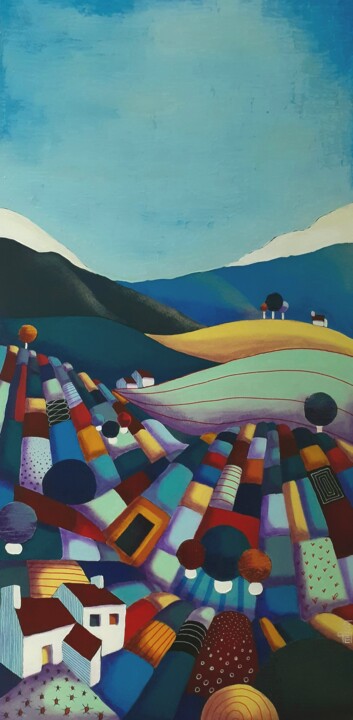
©2024 Marie-Pierre Jan
Ursprünge und Geschichte der zeitgenössischen Kunst
Die Geschichte der zeitgenössischen Kunst spielt sich in der Mitte des 20. Jahrhunderts ab und ist geprägt von seismischen Veränderungen in der künstlerischen Ausdrucksform. Nach dem Zweiten Weltkrieg begannen Künstler in den 1950er und 1960er Jahren, über die traditionellen Grenzen hinaus zu experimentieren und die Normen dessen, was Kunst sein konnte, in Frage zu stellen. Diese revolutionäre Ära brachte eine Vielzahl neuer künstlerischer Bewegungen und Formen hervor, wie zum Beispiel den abstrakten Expressionismus, die Pop-Art und den Minimalismus. Gemälde, die früher auf Realismus beschränkt waren, umarmten die Abstraktion, wobei Künstler Farbe und Form einsetzten, um Emotionen und Ideen auszudrücken. Bemerkenswerte Phasen wie das Aufkommen der Pop-Art Ende der 1950er und Anfang der 1960er Jahre sahen Kunstwerke, die die Populärkultur und die Massenmedien nachahmten und den Fokuswechsel der Gesellschaft widerspiegelten.
Die bildhauerischen Künste haben ebenfalls eine Metamorphose erfahren. Die Bildhauer begannen, mit neuen Materialien und Formen zu experimentieren und oft Kunstwerke zu schaffen, die mit dem Betrachter und dem umgebenden Raum interagieren und ein Gefühl der Verbindung fördern. Die zeitlose Praxis des Zeichnens hat sich ebenfalls weiterentwickelt, wobei Künstler innovative Techniken und Konzepte integrierten, um ihre Rolle in der zeitgenössischen Kunst neu zu definieren.
Die Fotografie, ein relativ neues Medium, hat sich zu einem mächtigen Werkzeug in der Landschaft der zeitgenössischen Kunst entwickelt. Im 19. Jahrhundert geboren, hat sie in der zweiten Hälfte des 20. Jahrhunderts wirklich Fahrt aufgenommen und die Grenzen zwischen den schönen Künsten und der Dokumentation verwischt. Die Gravur, eine Praxis, die auf die Antike zurückgeht, hat ein erneuertes Interesse und eine verstärkte Experimentierfreude mit Techniken wie Lithographie, Gravur und Siebdruck erfahren.
Das Universum der Textilkunst hat sich erheblich erweitert, da Künstler begannen, die Vielseitigkeit und taktile Qualität von Stoffen und Fasern zu schätzen. Künstler begannen Textilien zu verwenden, um die Grenzen zwischen bildender Kunst, Handwerk und Design in Frage zu stellen.
Das Aufkommen digitaler Technologie gegen Ende des 20. Jahrhunderts läutete eine neue Ära für die zeitgenössische Kunst ein. Digitale Kunst entstand, als Künstler begannen, neue Technologien zu nutzen, um immersive und interaktive Erfahrungen zu schaffen, wobei oft die Grenze zwischen der virtuellen und der physischen Welt verwischt wurde.
Durch diese Zeiten des Wandels ist das Wesen der zeitgenössischen Kunst dasselbe geblieben: ein dynamisches und sich ständig weiterentwickelndes Spiegelbild der Zeit, in der wir leben, das ständig Grenzen sprengt und das Neue umarmt, immer in Frage stellt und immer erkundet.
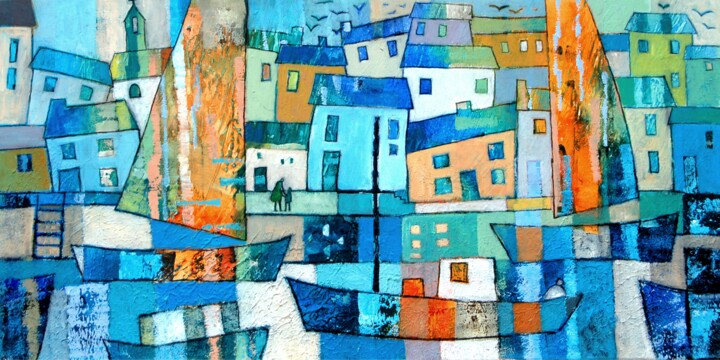
©2024 Claire Biette
Entwicklungen dieser zeitgenössischen Werke auf dem Kunstmarkt
Während wir uns durch das 21. Jahrhundert navigieren, entwickelt sich und erweitert sich die dynamische Landschaft der zeitgenössischen Kunst weiter und spiegelt unsere sich ständig verändernde Welt wider. Zeitgenössische Gemälde, einst hauptsächlich auf zwei dimensionale Leinwände beschränkt, umfassen nun eine Vielzahl von Formen und Techniken, von Multimedia-Installationen bis hin zu digitalen Kreationen, wobei jeder Teil ein reiches Geflecht aus Gedanken, Emotionen und Geschichten darstellt. Auch die Skulptur hat weitgehend die traditionellen Materialien wie Stein und Bronze überschritten, wobei Künstler Licht, Ton und sogar Bewegung einbeziehen und damit die Vergänglichkeit und den Fluss der modernen Welt verkörpern.
Die Fotografie hat in den Händen von zeitgenössischen Künstlern ihre Horizonte erweitert und sich nahtlos mit digitaler Technologie vermischt, um atemberaubende Bilder zu schaffen, die unsere Wahrnehmung der Realität in Frage stellen. Die Zeichnung hat ihrerseits die Grenzen des Papiers überschritten und multimediale Elemente und explorative Techniken integriert, um ihre Rolle im künstlerischen Diskurs neu zu definieren. Die Gravur blüht weiterhin, wobei Zeitgenössische Künstler traditionelle Methoden innovativ nutzen, um starke soziale und persönliche Kommentare zu liefern.
Textilkunst, früher als Handwerk betrachtet, spielt heute eine wichtige Rolle in der Welt der zeitgenössischen Kunst, da Künstler sie nutzen, um Fragen der Identität, Tradition und des kulturellen Erbes zu erforschen. In der Zwischenzeit hat die digitale Kunst, das neueste Mitglied der Familie der zeitgenössischen Kunst, die Art und Weise, wie wir Kunst schaffen und interagieren, revolutioniert und immersive Erfahrungen geboten, die die Grenze zwischen virtuell und physisch verwischen.
Diese verschiedenen Formen der zeitgenössischen Kunst haben einen bedeutenden Wert auf dem heutigen Kunstmarkt, nicht nur aufgrund ihrer ästhetischen Anziehungskraft, sondern auch aufgrund ihrer Fähigkeit, komplexe Ideen und Emotionen zu verkapseln und zu kommunizieren. Sammler, Kuratoren und Kunstliebhaber aus der ganzen Welt suchen nach diesen Werken, angezogen von ihrem intrinsischen Dynamismus, ihrer innovativen Verwendung von Materialien und ihren eloquenten Ausdrucksformen unserer geteilten menschlichen Erfahrung. Als Zeugnis unserer Zeit verkapseln diese zeitgenössischen Kunstwerke den Impuls unserer Gesellschaft und die Resonanz individueller Stimmen und gravieren unsere kollektive Erzählung für immer in die Annalen der Kunstgeschichte ein.
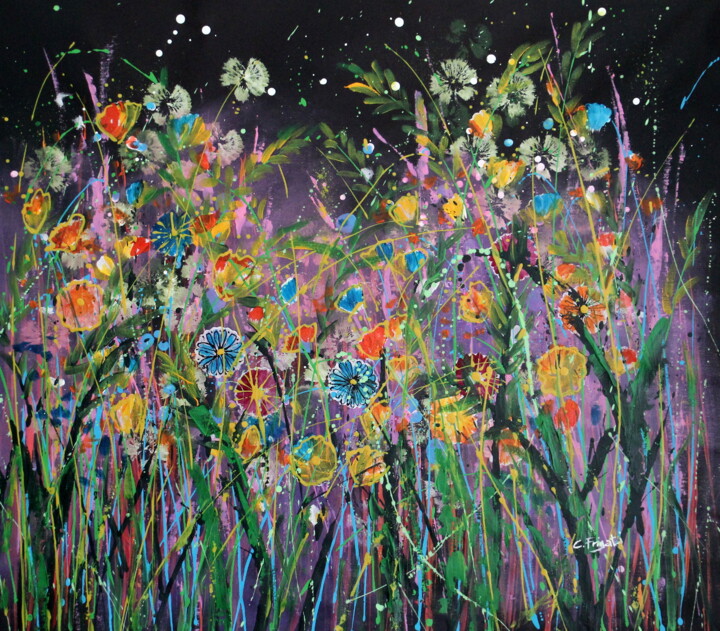
©2024 Cecilia Frigati
Berühmte zeitgenössische Künstler
Während wir in die vibrierende Welt der zeitgenössischen Kunst eintauchen, begegnen wir einer Vielzahl von Künstlern, die dieses dynamische Feld gestalten. Jeder von ihnen ist ein Meister in seinem Medium - Malerei, Skulptur, Fotografie, Zeichnung, Druckgrafik, Textil oder digitale Kunst - sie erweitern die künstlerischen Grenzen und spiegeln unsere Zeit wider und hinterfragen unsere Wahrnehmungen. Lassen Sie uns diese bemerkenswerten Beiträger und ihre revolutionären Werke erkunden.
1. Gerhard Richter - Bekannt für seinen facettenreichen Ansatz in der Malerei, fordert Richter die Grenzen des Mediums heraus und wechselt geschickt zwischen abstrakten und hyperrealistischen Stilen. Seine Werke, ob sie nun mit einem Spachtel gestreckte Pigmente oder unscharfe fotografische Bilder zeigen, führen einen faszinierenden Dialog mit der Wahrnehmung.
2. Jeff Koons - Ein wichtiger Vertreter der zeitgenössischen Skulptur, Koons schafft monumentale Werke, die Themen wie Konsum, Geschmack und Popkultur erforschen. Seine ikonischen Ballontiere, die aus spiegelglänzendem Edelstahl gefertigt sind, begeistern durch ihre sowohl spielerische als auch tiefgründige Aussage.
3. Cindy Sherman - Eine renommierte Fotografin, die ihr Objektiv nutzt, um Identität und soziale Rollen zu erforschen, insbesondere die von Frauen. Bekannt für ihre konzeptionellen Selbstporträts, übernimmt sie eine Vielzahl von Charakteren und erweitert die Grenzen der Fotografie als künstlerischen Ausdrucksform.
4. David Hockney - Hockney, mit einer umfangreichen Produktion über sechs Jahrzehnte hinweg, ist eine Schlüsselfigur der zeitgenössischen Zeichenkunst. Sein kühner Einsatz von Farbe und seine spielerische Erkundung der Perspektive vermitteln ein berauschendes Gefühl von Freude und eine uneingeschränkte Feier des Lebens.
5. Kiki Smith - Eine innovative Graveurin, Smiths Arbeit erforscht den menschlichen Zustand, insbesondere den weiblichen Körper und seine sozialen und kulturellen Konnotationen. Ihre Kupferstiche und Lithografien rufen universelle Erfahrungen des Lebens, des Todes und der Transformation hervor.
6. El Anatsui - Als Meister der Textilkunst schafft Anatsui wunderschöne Installationen, die aus weggeworfenen Flaschenverschlüssen und Aluminiumstücken wie Wandteppiche aussehen. Diese flexiblen und glitzernden Skulpturen vereinen traditionelle afrikanische Ästhetik und zeitgenössische künstlerische Sensibilität und behandeln Themen wie Konsum, Abfall und die Vernetztheit unserer Welt.
7. Rafael Lozano-Hemmer - Eine herausragende Persönlichkeit der digitalen Kunst, Lozano-Hemmer nutzt Technologie, um interaktive Installationen zu schaffen, die Architektur und Performance-Kunst kombinieren. Seine oft partizipativen Arbeiten erforschen Themen wie Überwachung, Privatsphäre und die Beziehung zwischen Menschen und ihrer Umwelt.
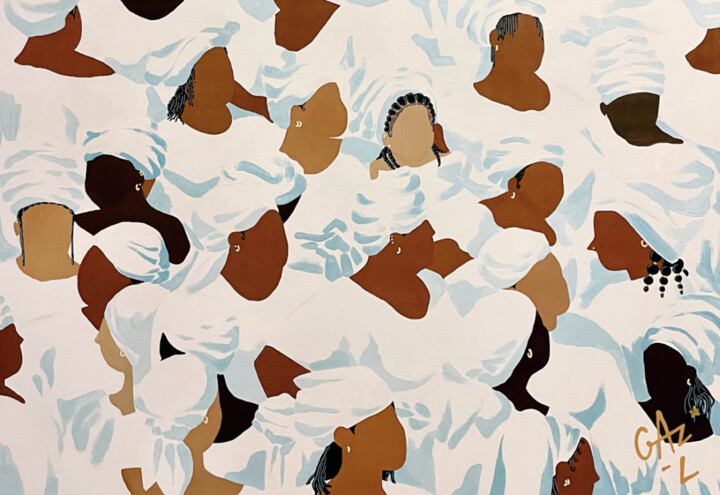
©2024 Hugues Matumona
Bemerkenswerte zeitgenössische Kunstwerke
Das Panorama der zeitgenössischen Kunst ist ein dynamisches Patchwork aus verschiedenen Ausdrucksformen und innovativen Ideen, wobei jedes Werk einen einzigartigen Dialog mit seinem Publikum darstellt. Hier ist eine Auswahl renommierter zeitgenössischer Kunstwerke, die verschiedene Medien wie Malerei, Skulptur, Fotografie, Zeichnung, Druckgrafik, Textilkunst und digitale Kunst umfassen und diese lebhafte Bewegung tiefgreifend beeinflusst haben.
Diese Werke, in ihrer Vielfalt, illustrieren das reichhaltige Muster der zeitgenössischen Kunst, wobei jedes Stück ein einzigartiger Kommentar über unsere Welt und ein Zeugnis des unbegrenzten Potenzials kreativen Ausdrucks ist.
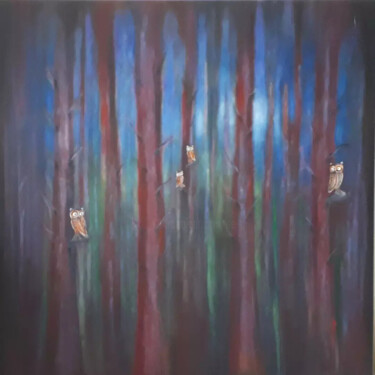
Sylvid
Acryl auf Leinwand | 31,5x31,5 in
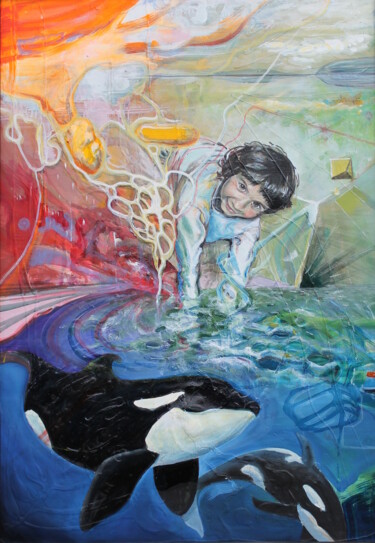
Stefani Ruprecht
Acryl auf Leinen Leinwand | 39,4x27,6 in
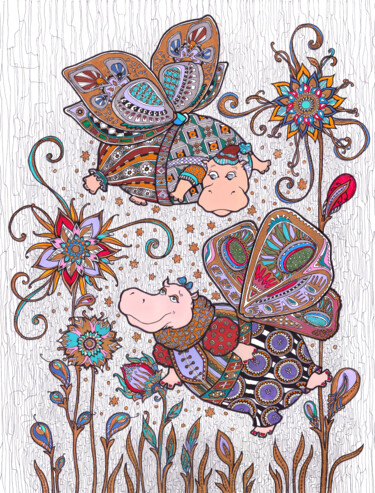
Inna Viriot
Acryl auf Papier | 25,6x19,4 in
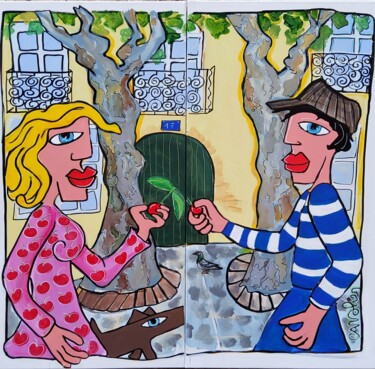
Caroline Cavalier
Acryl auf Leinen Leinwand | 39,4x39,4 in
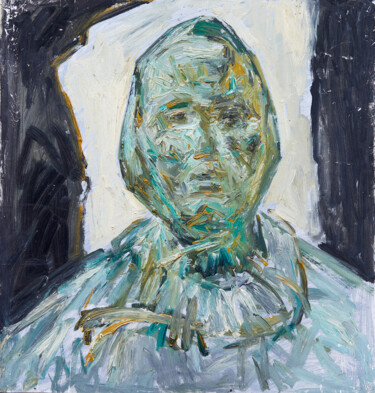
Zakhar Shevchuk
Öl auf MDF-Platte | 24,4x23,6 in
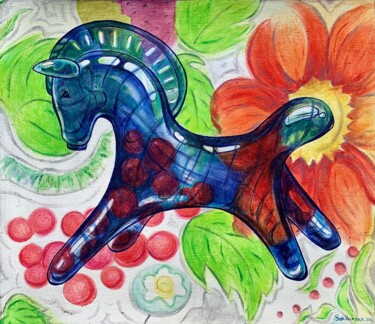
Seksikoza Loveenergy Style Contemporary
Acryl auf Leinen Leinwand | 23,6x27,6 in
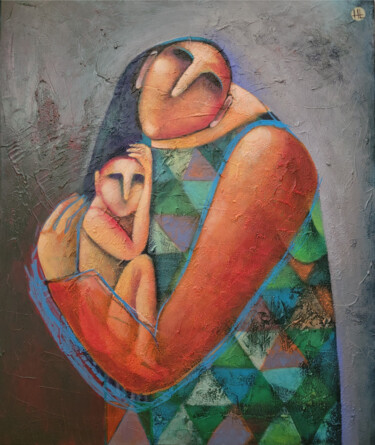
Liana Asatryan
Öl auf Leinwand | 27,6x23,6 in
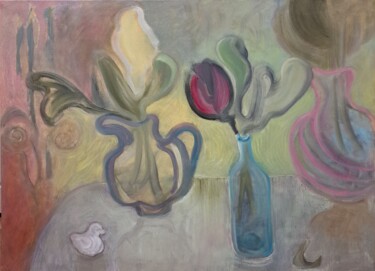
Oksana Golichenkova
Öl auf Leinwand | 43,3x54,3 in

Cecilia Frigati
Acryl auf Leinwand | 29,1x32,3 in
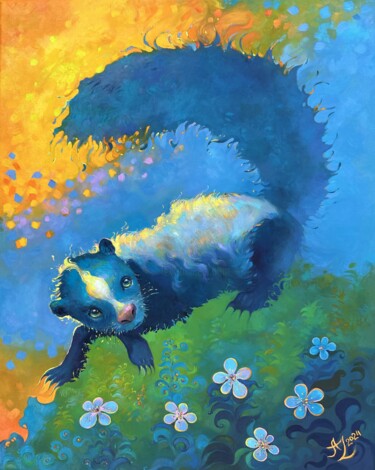
Anita Zotkina
Öl auf Leinwand | 20x16 in
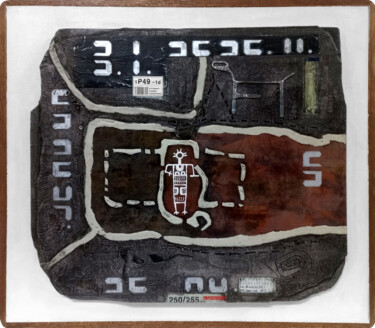
Seven E
Acryl auf Leinwand | 21,7x24,8 in




